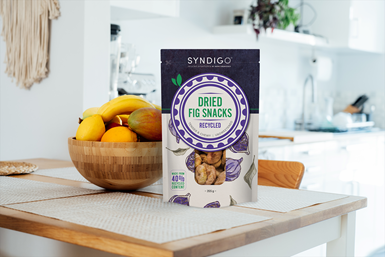Polyethylene Innovations Abound for Films, Conduit
Highlights of the 2023 SPE Polyolefins Conference include a novel HDPE for oriented films, high-performance recycled LDPE and LLDPE film resins, and a bimodal HDPE for conduits.

HDZ268 bimodal HDPE is said to result in blown MDO-PE and BOPE films with high, uniform orientation, gauge stability, easy processability and low gels.
Photo Credit: ExxonMobil Chemical
New developments in materials, additives, and processing — with a focus on sustainability — were dominant themes at SPE’s International Polyolefins 2023 conference, held in Galveston, Texas, in early March. Additives that enhance recycled polyolefins were among the presentations, most of which we have previously reported in the last year and were highlighted at K 2022.
Here, we highlight some of the latest polyolefin resin developments, which include a novel HDPE for oriented films; high-performance, PCR-rich LDPE and LLDPE film resins; and a bimodal HDPE for conduits.
Bimodal HDPE for Oriented Films
ExxonMobil discussed the development of a novel HDPE driven by a market pull from brand owners and processors seeking all-PE packaging, which has created demand for print webs made of either biaxially oriented polyethylene (BOPE) or blown machine-direction oriented (MDO-PE) films. As reported previously, this is being driven mainly by sustainability goals with a focus on fully recyclable packaging made using single materials such as PE or PP.
This increased interest from flexible packaging converters and brand owners has made it clear that there is a need for development of new HDPE resins that will work well in blown MDO-PE and tenter-frame BOPE processes. Food packaging applications switching from multimaterial (BOPET or BOPP/adhesive/PE) to monomaterial PE laminates include products such as nuts, crackers, condiments, granola bars and potato chips.
In biaxially oriented films, use of HDPE resins and blends can be challenging due to the relatively fast crystallization and narrow operating window. Moreover, HDPE resins for BOPE and MDO-PE films require an optimal design in order to compete in properties like stiffness, heat resistance and optics with other oriented films such as BOPP, BOPET and BOPA (nylon).
To that end, ExxonMobil developed HDZ268, a 0.961-g/cc and 0.65 MI ethylene-alpha-olefin copolymer with broad molecular-weight distribution and highly branched architecture. It is said to result in blown MDO-PE and cast BOPE films with high, uniform orientation, gauge stability, easy processability and low gels. The new HDPE was tested on blown MDO-PE and tenter-frame BOPE lines where the processability and physical properties of films created from the new grade were studied under different processing conditions.
According to the researchers, the HDZ268-series HDPE allows them to produce MDO-PE containing as much as 60% to 70% HDPE. The new resin provides high ouput while maintaining bubble stability; MDP stretch ratios up to 6:1 and 7:1; and excellent optics, with haze below 10% and 45° gloss above 60%.
ExxonMobil researchers also produced tenter-frame BOPEs that were HDPE-rich. They were run in a wide variety of stretch ratios (MDO × TDO) including 4.8 × 8.5, 4 × 8.5, 5.5 × 8. They offer very high stiffness: 1% secant modulus up to 100 kpsi or higher MD and up to 300 kpsi or higher TD. They also provide higher tear resistance than unoriented HDPE films and LDPE-based BOPE films.
PCR-Rich PE Family
At the conference, Dow discussed the development of a new PCR-rich family of film resins through its long-term collaboration with Houston-based Avangard Innovative LP, said to be the largest producer of PCR resins from film in the Americas.
Dow’s new Revoloop family initially includes two commercial grades, both containing 70% PCR. These are not intended for food contact or articles that will be used for production of primary food-contact packaging or containers.
- Revoloop 70LD NA LDPE (0.925 g/cc, 0.53 MI) is designed for collation shrink films. It is said to be best suited for use in the core layer (up to 80% of total thickness) of multilayer structures.
- Revoloop 70LL NA LLDPE (0.918 g/cc, 1.7 MI) is designed for secondary and tertiary packaging and has potential in some non-food primary packaging.
According to the research team, when combined with other high-performance resins from Dow, the Revoloop PCR-rich resins have been shown to provide improved aesthetic and performance consistency over comparable PCR dryblends. The boast more homogeneity and consistency, as well as reduced gels.
As previously reported, other polyolefin resin producers that have developed new portfolios of mechanically recycled and/or chemically recycled resins include Braskem, Borealis, ExxonMobil, Ineos Polyolefins, LyondellBasell, SABIC, and Nova Chemicals.
Part of Nova’s Syndigo rPE portfolio introduced in early 2023, Syndigo rPE-0860-FC is sourced from natural HDPE milk jugs and is suited to various types of flexible and rigid food packaging.

NOVA Chemicals launched its first mechanically recycled, FDA-compliant food-contact HDPE a week after the conference. (Photo: NOVA Chemicals)
Bimodal HDPE Conduit & Microduct Resin
Among polyolefin advances for telecom network infrastructure, Dow has developed a new bimodal HDPE conduit and microduct resin. Produced via Unipol II process techology, Continuum DGDA-2488 NT is specifically designed for use in all duct and cable-in-conduit (CIC) applications for both telecommunications and power cables. Typical uses include high-performance conduit for fiber-optic networks and 5G expansion. The natural resin combined with colorants can be readily processed by any current duct or conduit extrusion method in all sizes at commercial rates.
According to the research team, the new bimodal HDPE (>0.947-0.955 g/cc, <0.4-0.15 MI) was developed to surpass the properties and processing performance of unimodal HDPE grades predominantly used in these applications today (>0.940-0.947 g/cc, 0.4-0.15 MI). The material’s new cell classification of PE435540 C/E reportedly meets or exceeds all ASTM D 3350 conduit resin requirements.
In extrusion trials on a 60-mm, 30:1 L/D extruder for a 1-in. DR (dimension ratio) 11 pipe, the bimodal HDPE ran at higher specific rates (6.3 vs. 5.9) and lower energy input (530 J/g vs. 570 J/g) than a comparable unimodal HDPE conduit grade. In field trials, one pipe processor’s observations were as follows:
- The change from unimodal to bimodal HDPE delivered a 10% increase in output.
- Head pressure, motor current and melt temperature were comparable to those with unimodal HDPE.
- Bimodal HDPE was easier to process than unimodal resin:
- Average changeover time was reduced from 1.94 hr to 1.85 hr, a 5% gain, and it increased machine uptime
- The scrap rate decreased by 30% due to shorter time to bring product within specifications.
Related Content
Density & Molecular Weight in Polyethylene
This so-called 'commodity' material is actually quite complex, making selecting the right type a challenge.
Read MorePolyethylene Fundamentals – Part 4: Failed HDPE Case Study
Injection molders of small fuel tanks learned the hard way that a very small difference in density — 0.6% — could make a large difference in PE stress-crack resistance.
Read MoreNew Entrant Heartland Polymers Stepping up as Reliable Supplier
Heartland Polymers’ new Alberta, Canada facility will produce 525 KTA propylene and 525 KTA polypropylene. It is expected to stabilize supply chains across the continent.
Read MoreImproving Twin-Screw Compounding of Reinforced Polyolefins
Compounders face a number of processing challenges when incorporating a high loading of low-bulk-density mineral filler into polyolefins. Here are some possible solutions.
Read MoreRead Next
Advanced Recycling: Beyond Pyrolysis
Consumer-product brand owners increasingly see advanced chemical recycling as a necessary complement to mechanical recycling if they are to meet ambitious goals for a circular economy in the next decade. Dozens of technology providers are developing new technologies to overcome the limitations of existing pyrolysis methods and to commercialize various alternative approaches to chemical recycling of plastics.
Read MoreProcessor Turns to AI to Help Keep Machines Humming
At captive processor McConkey, a new generation of artificial intelligence models, highlighted by ChatGPT, is helping it wade through the shortage of skilled labor and keep its production lines churning out good parts.
Read More
























